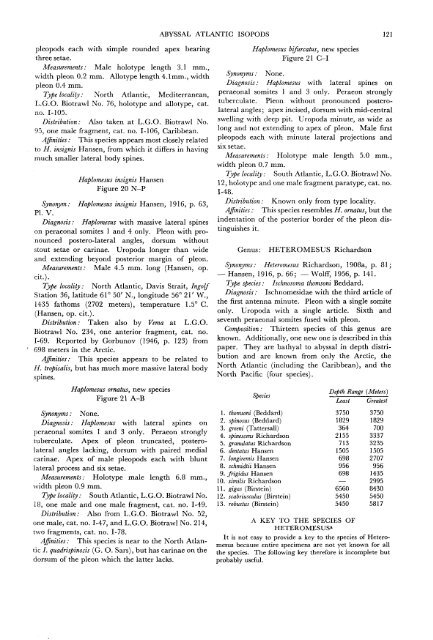The Isopods of Abyssal Depths in the Atlantic Ocean
The Isopods of Abyssal Depths in the Atlantic Ocean
The Isopods of Abyssal Depths in the Atlantic Ocean
You also want an ePaper? Increase the reach of your titles
YUMPU automatically turns print PDFs into web optimized ePapers that Google loves.
pleopods each with simple rounded apex bear<strong>in</strong>g<br />
three setae.<br />
Measurements: Male holotype length 3.1 mm.,<br />
width pleon 0.2 mm. Allotype length 4.1mm., width<br />
pleon 0.4 mm.<br />
Type locality: North <strong>Atlantic</strong>, Mediterranean,<br />
L.G.O. Biotrawl No. 76, holotype and allotype, cat.<br />
no. 1-105.<br />
Distribution: Also taken at L.G.O. Biotrawl No.<br />
95, one male fragment, cat. no. 1-106, Caribbean.<br />
Aff<strong>in</strong>ities: This species appears most closely related<br />
to H. <strong>in</strong>signis Hansen, from which it differs <strong>in</strong> hav<strong>in</strong>g<br />
much smaller lateral body sp<strong>in</strong>es.<br />
Haplomesus <strong>in</strong>signis Hansen<br />
Figure 20 N-P<br />
Synonym: Haplomesus <strong>in</strong>signis Hansen, 1916, p. 63,<br />
PL V.<br />
Diagnosis: Haplomesus with massive lateral sp<strong>in</strong>es<br />
on peraeonal somites 1 and 4 only. Pleon with pronounced<br />
postero-lateral angles, dorsum without<br />
stout setae or car<strong>in</strong>ae. Uropoda longer than wide<br />
and extend<strong>in</strong>g beyond posterior marg<strong>in</strong> <strong>of</strong> pleon.<br />
Measurements: Male 4.5 mm. long (Hansen, op.<br />
cit.).<br />
Type locality: North <strong>Atlantic</strong>, Davis Strait, Ingolf<br />
Station 36, latitude 61° 50' N., longitude 56° 21' W.,<br />
1435 fathoms (2702 meters), temperature 1.5° C.<br />
(Hansen, op. cit.).<br />
Distribution: Taken also by Vema at L.G.O.<br />
Biotrawl No. 234, one anterior fragment, cat. no.<br />
1-69. Reported by Gorbunov (1946, p. 123) from<br />
698 meters <strong>in</strong> <strong>the</strong> Arctic.<br />
Aff<strong>in</strong>ities: This species appears to be related to<br />
H. tropicalis, but has much more massive lateral body<br />
sp<strong>in</strong>es.<br />
Haplomesus ornatus, new species<br />
Figure 21 A-B<br />
Synonyms: None.<br />
Diagnosis: Haplomesus with lateral sp<strong>in</strong>es on<br />
peraeonal somites 1 and 3 only. Peraeon strongly<br />
tuberculate. Apex <strong>of</strong> pleon truncated, posterolateral<br />
angles lack<strong>in</strong>g, dorsum with paired medial<br />
car<strong>in</strong>ae. Apex <strong>of</strong> male pleopods each with blunt<br />
lateral process and six setae.<br />
Measurements: Holotype male length 6.8 mm.,<br />
width pleon 0.9 mm.<br />
Type locality: South <strong>Atlantic</strong>, L.G.O. Biotrawl No.<br />
18, one male and one male fragment, cat. no. 1-49.<br />
Distribution: Also from L.G.O. Biotrawl No. 52,<br />
one male, cat. no. 1-47, and L.G.O. Biotrawl No. 214,<br />
two fragments, cat. no. 1-78.<br />
Aff<strong>in</strong>ities: This species is near to <strong>the</strong> North <strong>Atlantic</strong><br />
/. quadrisp<strong>in</strong>osis (G. O. Sars), but has car<strong>in</strong>ae on <strong>the</strong><br />
dorsum <strong>of</strong> <strong>the</strong> pleon which <strong>the</strong> latter lacks.<br />
ABYSSAL ATLANTIC ISOPODS 121<br />
Haplomesus bifurcatus, new species<br />
Figure 21 C-I<br />
Synonyms: None.<br />
Diagnosis: Haplomesus with lateral sp<strong>in</strong>es on<br />
peraeonal somites 1 and 3 only. Peraeon strongly<br />
tuberculate. Pleon without pronounced posterolateral<br />
angles; apex <strong>in</strong>cised, dorsum with mid-central<br />
swell<strong>in</strong>g with deep pit. Uropoda m<strong>in</strong>ute, as wide as<br />
long and not extend<strong>in</strong>g to apex <strong>of</strong> pleon. Male first<br />
pleopods each with m<strong>in</strong>ute lateral projections and<br />
six setae.<br />
Measurements: Holotype male length 5.0 mm.,<br />
width pleon 0.7 mm.<br />
Type locality: South <strong>Atlantic</strong>, L.G.O. Biotrawl No.<br />
12, holotype and one male fragment paratype, cat. no.<br />
1-48.<br />
Distribution: Known only from type locality.<br />
Aff<strong>in</strong>ities: This species resembles H. ornatus, but <strong>the</strong><br />
<strong>in</strong>dentation <strong>of</strong> <strong>the</strong> posterior border <strong>of</strong> <strong>the</strong> pleon dist<strong>in</strong>guishes<br />
it.<br />
Genus: HETEROMESUS Richardson<br />
Synonyms: Heteromesus Richardson, 1908a, p. 81;<br />
— Hansen, 1916, p. 66; — Wolff, 1956, p. 141.<br />
Type species: Ischnosoma thomsoni Beddard.<br />
Diagnosis: Ischnomesidae with <strong>the</strong> third article <strong>of</strong><br />
<strong>the</strong> first antenna m<strong>in</strong>ute. Pleon with a s<strong>in</strong>gle somite<br />
only. Uropoda with a s<strong>in</strong>gle article. Sixth and<br />
seventh peraeonal somites fused with pleon.<br />
Composition: Thirteen species <strong>of</strong> this genus are<br />
known. Additionally, one new one is described <strong>in</strong> this<br />
paper. <strong>The</strong>y are bathyal to abyssal <strong>in</strong> depth distribution<br />
and are known from only <strong>the</strong> Arctic, <strong>the</strong><br />
North <strong>Atlantic</strong> (<strong>in</strong>clud<strong>in</strong>g <strong>the</strong> Caribbean), and <strong>the</strong><br />
North Pacific (four species).<br />
1. thomsoni (Beddard)<br />
2. sp<strong>in</strong>osus (Beddard)<br />
3. greeni (Tattersall)<br />
4. sp<strong>in</strong>escens Richardson<br />
5. granulatus Richardson<br />
6. dentatus Hansen<br />
7. longiremis Hansen<br />
8. schmidtii Hansen<br />
9. frigidus Hansen<br />
10. similis Richardson<br />
11. gigas (Birste<strong>in</strong>)<br />
12. scabriusculus (Birste<strong>in</strong>)<br />
13. robustus (Birste<strong>in</strong>)<br />
Least<br />
3750<br />
1829<br />
364<br />
2155<br />
713<br />
1505<br />
698<br />
956<br />
698<br />
—<br />
6560<br />
5450<br />
5450<br />
Greatest<br />
3750<br />
1829<br />
700<br />
3337<br />
3235<br />
1505<br />
2707<br />
956<br />
1435<br />
2995<br />
8430<br />
5450<br />
5817<br />
A KEY TO THE SPECIES OF<br />
HETEROMESUS a<br />
It is not easy to provide a key to <strong>the</strong> species <strong>of</strong> Heteromesus<br />
because entire specimens are not yet known for all<br />
<strong>the</strong> species. <strong>The</strong> follow<strong>in</strong>g key <strong>the</strong>refore is <strong>in</strong>complete but<br />
probably useful.

















